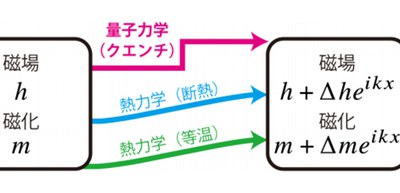
Relation between two thermodynamic susceptibilities and quench susceptibility
First step toward the understanding of consistency between quantum mechanics and thermodynamics
A research group of scientists from The University of Tokyo and Osaka University has theoretically discovered a relation between quantum mechanics and thermodynamics.
In physics, the behavior of matter is believed to be governed by quantum mechanics at the microscopic scale and by thermodynamics at the macroscopic scale. Although the dynamics of the microscopic system is time reversal invariant (TRI), the macroscopic system is independent of time. Thus, the consistency of thermodynamics with quantum mechanics is still an open problem.
For the correct correspondence between micro- and macro-realms, the susceptibility obtained by the quench experiment needs to coincide with a thermodynamic susceptibility. However, it was unclear whether the quench susceptibility should be compared with either one of the two thermodynamic susceptibilities (the adiabatic and isothermal susceptibilities) and what conditions should be satisfied for them to coincide.
Recently, it has become possible to isolate a quantum system from its environment over a reasonably long period, which enables the direct observation of the dynamics of isolated quantum systems (e.g., ultracold atoms, which simulate the XYZ spin chain) induced by suddenly changing a physical parameter. After this so-called "quench," the system often relaxes to a steady state, where the expectation values of local observables become almost time independent. Thus, the time evolution following a quantum quench is studied to discuss correspondence between quantum mechanics and thermodynamics.
In this study, the researchers considered the magnetic susceptibility of a quantum spin system. In this situation, the quench susceptibility (the rate of magnetization change induced by a quench in quantum mechanics) is a function of wave vector k.
This group showed that the magnetic susceptibility obtained by the quench experiment on isolated quantum systems was discontinuous. When the dynamics of the system was complicated enough, the quench susceptibility was discontinuous at k=0 as a function of k. The discontinuous values (the values at k = 0 and the k → 0 limit) coincided with the adiabatic susceptibility and the isothermal susceptibility, respectively.
They also revealed a new necessary condition for thermalization, the process of physical bodies reaching thermal equilibrium through mutual interaction. The condition was different from those previously discovered to relax physically relevant quantities to the expectation value after quench in thermodynamics.
In order to give predictions on how these particular behaviors can be observed in experiments in the isolated quantum systems and how they deviate when the conditions are not fully satisfied, they obtained the adiabatic and isothermal susceptibilities as a function of wave vector k.
While when the dynamics of the system was complicated enough, the above-mentioned behavior was observed, when the dynamics of the system was not complicated, conditions were not satisfied and the susceptibility obtained by the quench experiment didn’t coincide with either of the thermodynamic susceptibilities.
This group’s achievements could be considered the first step toward understanding the consistency between quantum mechanics and thermodynamics. It is anticipated that the anomalous behaviors of the quench susceptibilities revealed by this study will be verified experimentally.

Figure 1

Figure 2
The article, “Anomalous behavior of magnetic susceptibility obtained by quench experiments in isolated quantum systems” was published in Physical Review Letters at DOI: https://journals.aps.org/prl/abstract/10.1103/PhysRevLett.124.110609
Related Links
